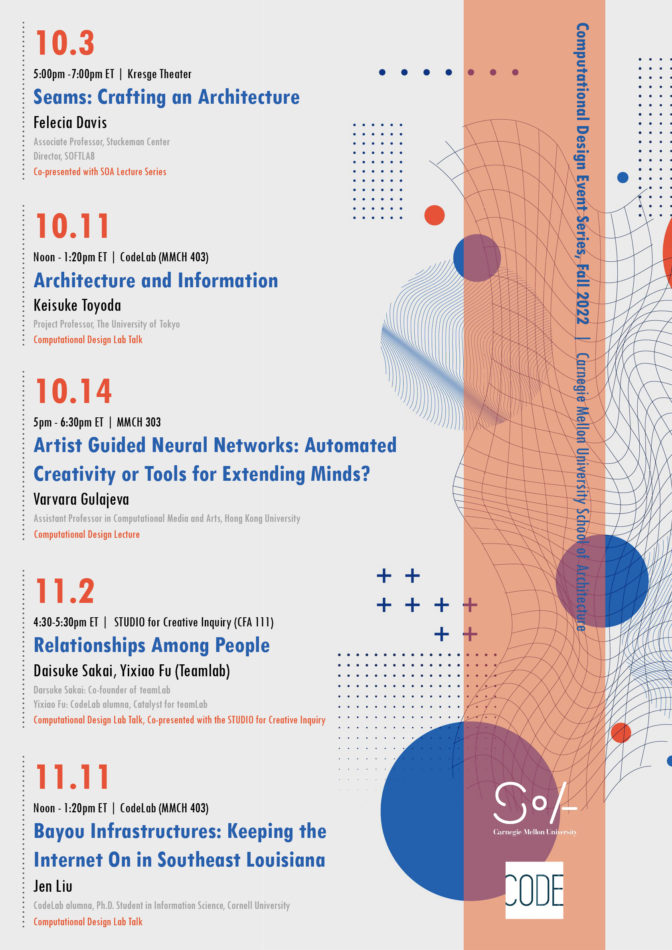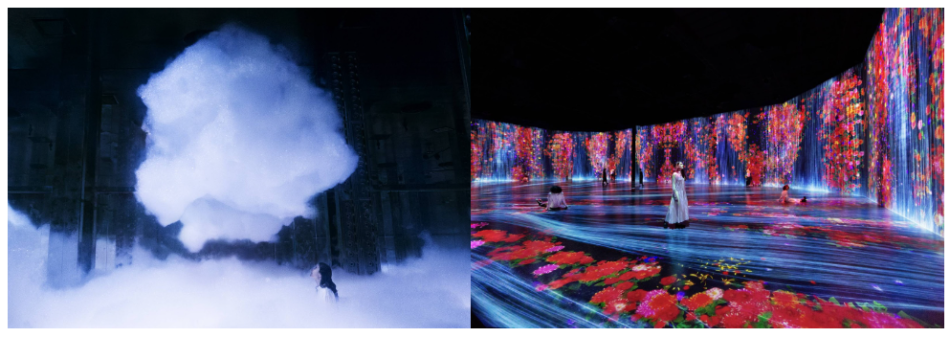Computational Design Event Series, Fall ’22

Events:
Monday October 3rd, 5:00pm -7:00pm ET | Kresge Theater
Seams: Crafting an Architecture
Felecia Davis
Associate Professor, Stuckeman Center; Director, SOFTLAB
Co-presented with the SoA Lecture Series

The path that one walks as a Black architect or designer has many seams, or places that one improvises and stitches together to make a story, or really understand where one is in the world and how to make sense of things that cannot under any circumstances make any sense and never did. There are many gaps and lacunae that are bridged by these seams. Working along these gaps constructs a place of creativity, and ways of making that integrate fragments from the past but in fact also project a future. Davis will present prior and current works in computational textiles or textiles that use sensors or microcontrollers or simply the natural properties of the textile itself to communicate some information to people. These projects are examples of soft architectures and work along a seam.
Felecia Davis’ work in computational textiles questions how we live and she re-imagines how we might use textiles in our daily lives and in architecture. Davis is an Associate Professor at the Stuckeman Center for Design Computing in the School of Architecture at Pennsylvania State University and is the director of SOFTLAB@PSU. She completed her PhD in Design Computation at MIT. Davis’ work in architecture connects art, science, engineering and design and was featured by PBS in the Women in Science Profiles series. Davis’ designs were part of the MoMA’s exhibition Reconstruction: Blackness and Architecture in America. She is a founding member of the Black Reconstruction Collective, a not-for-profit group of Black architects, scholars and artists supporting design work about the Black diaspora. Davis’ work has been recently recognized by the DigitalFUTURES Group in 2021 for the Black Flower Antenna and the New York Architectural Leagues’ 2022 Emerging Voices in Architecture program.
———————————————————————————————————————————–
Tuesday October 11th, Noon – 1:20pm ET | CodeLab (MMCH 403)
Architecture and Information
Keisuke Toyoda
Project Professor, The University of Tokyo
Computational Design Lab Talk
This talk explores both our architectural work (as NOIZ architects), as well as our research project at the U-Tokyo (about Common Ground), in work across AR/VR/XR, smart city, autonomous mobility, game engines, and AI.
Keisuke Toyoda was born in 1972 in Chiba, Japan. Work experience included Tadao Ando Architect & Associates (1996- 2000), SHoP Architects (2002-2006, New York). He founded NOIZ with Jia-Shuan Tsai in 2007, based in both Tokyo and Taipei. Kosuke Sakai has joined since 2016 as a partner. Warsaw office opened in 2020. In 2017 Toyoda co-founded gluon with Mitsuhiro Kanada, a consulting and advisory firm on the issues about Common Ground. He served as an advisor for EXPO 2025 OSAKA venue design for bidding (2017-2018). He founded and now serves as a vice chairman for Architectural Informatics Society (2020-) and advisor for Osaka Common Ground Living Lab (2020-). Toyoda has joined the Institute of Industrial Science, The University of Tokyo as a Visiting Professor, then promoted to a Project Professor and vice chair of the Center for Interspace by October, 2021.
———————————————————————————————————————————–
Friday October 14th, 5pm – 6:30pm ET | MMCH 303
Artist Guided Neural Networks: Automated Creativity or Tools for Extending Minds?
Varvara Gulajeva
Assistant Professor in Computational Media and Arts, Hong Kong University
Computational Design Lecture
Technology, like AI, is present in the generation and the distribution of culture. How do artists exploit neural networks for creative purposes, and what impact have these algorithms on contemporary practices? Through practice-based research methods, we have been exploring the potentials and limits of current AI technology, more precisely neural networks in the context of image, text, and form. From the proof of concept, deep learning (DL) has evolved into a tool that is applied for art production. Even more, we see a specific genre or cluster emerging that specifically concentrates on art made with AI. In terms of DL development, in a relatively short time, the generation of high-resolution images and 3D objects has been achieved. What is more exciting, there are models, like CLIP and text2mesh, that do not need the same kind of media input as the output. The first one is the text-to-image model. Such a twist contributes toward creativity arousal, which manifests itself in art practice and feeds back to the developers’ pipeline. Yet again, we see how the artists act as catalysts for technology development.
Such novel creative scenarios and processes are enabled not only by available AI models but by the hard work behind implementing these new technologies into real-time and autonomous applications with custom-made data sets and algorithms. AI does not create a ‘push the button’ masterpiece but requires quite a deep understanding of the technology behind it and a creative mind to come up with high-quality work. Our previous research has shown that the most interesting and valuable results are achieved when DL tools are combined with human input. Thus, AI opens new avenues for inspiration and offers novel tool sets but fails to automate creativity.
Dr Varvara Guljajeva is an artist and researcher holding the position of Assistant Professor in Computational Media and Arts Thrust at the Hong Kong University of Science and Technology (Guangzhou). Previously, she held positions at the Estonian Academy of Arts and Elisava Design School in Barcelona. Varvara was invited as a visiting researcher to XRL, Creative School of Media in the Hong Kong City University, IAMAS (Ogaki, Japan), LJMU (Liverpool, UK), Interface Cultures in the Linz University of Art, and Design, Blekinge Institute of Technology (Karlshamn, Sweden). Her PhD thesis “From Interaction to Post-Participation: The Disappearing Role of the Active Participant” (defended in 2018 in the Estonian Academy of Arts) was selected as the highest-ranking abstracts by Leonardo Labs in 2020. As an artist, she works together with Mar Canet forming an artist duo Varvara & Mar. Often the duo’s work is inspired by the information age. In their practice, they confront social changes and the impact of the technological era. The duo has been exhibiting in international shows since 2009. Their works were shown at MAD in New York, FACT in Liverpool, Santa Monica in Barcelona, Barbican in London, Onassis Cultural Centre in Athens, Ars Electronica museum in Linz, ZKM in Karlsruhe, and more.
———————————————————————————————————————————–
Wednesday November 2rd, 4:30-5:30pm ET | STUDIO for Creative Inquiry (CFA 111)
Relationships Among People
Darsuke Sakai: Co-founder of teamLab
Yixiao Fu: CodeLab alumna, Catalyst for teamLab
Computational Design Lab Talk, Co-presented with the STUDIO for Creative Inquiry

Daisuke Sakai, a co-founder of teamLab, speaks about the theme of ‘Relationships Among People’, one of teamLab’s concepts which aims to explore a new relationship among people, and to make the presence of others a positive experience through digital art. Sakai will introduce such concepts along with teamLab’s works. CodeLab alumna Yixiao Fu, who works as a Catalyst for teamLab, will also join us online to discuss her activities as a student and the projects she has been working on since joining teamLab.
TeamLab (f. 2001) is an international art collective. Their collaborative practice seeks to navigate the confluence of art, science, technology, and the natural world. Through art, the interdisciplinary group of specialists, including artists, programmers, engineers, CG animators, mathematicians, and architects, aims to explore the relationship between the self and the world, and new forms of perception.
———————————————————————————————————————————–
Friday November 11th, Noon – 1:20pm ET | CodeLab (MMCH 403)
Bayou Infrastructures: Keeping the Internet On in Southeast Louisiana
Jen Liu
CodeLab alumna, Ph.D. Student in Information Science, Cornell University
Computational Design Lab Talk
What does “keeping the Internet on” look like on shifting lands? In this presentation, I will discuss my ongoing research in southeast Louisiana, in which I examine the practices of sustaining and developing networked infrastructures in a time of social and ecological issues. Southeast Louisiana is a place that is experiencing accelerated impacts of climate change. The ongoing legacy of extractive industries has led to uneven development and deep socioeconomic disparities in this region, while increased intensity of storms and floods due to climate change have begun to impede and damage networked infrastructure. In particular, I focus on the work that utilities, service providers, and communities engage in to recover infrastructures post-storm. By focusing on these efforts, I use maintenance and repair as a lens of understanding how the climate crisis affects networked infrastructure in coastal landscapes. What planning is happening at the state level to move towards more resilient infrastructures? What labor is necessary to recover Internet access after a storm? How does this affect how designers and technologists imagine a connected world?
Jen Liu is a researcher, designer, artist, or educator depending on the context. Her research investigates the ecological, social, and political implications of computing technologies and infrastructures. She uses ethnographic and design methods to understand these challenges and build alternatives for livable and equitable futures. Her research examines climate change + networked infrastructures, land politics + digital agriculture, and environmental sensing + knowledge production. Liu is a PhD student in Information Science at Cornell University. She completed a masters in Tangible Interaction Design (MTID) at Carnegie Mellon University and my BFA in Fiber Arts from the Maryland Institute College of Art.
Category: News